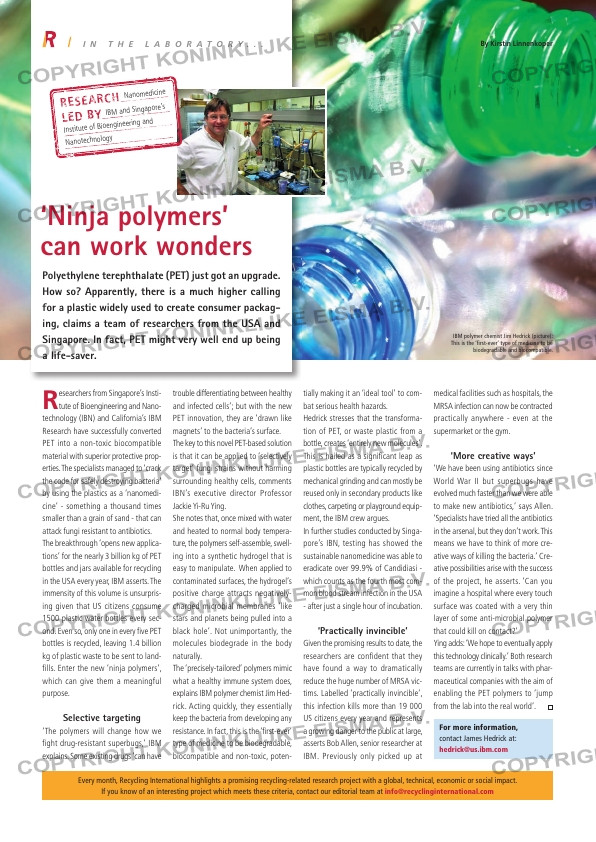Page 69 from: March 2014

I N T H E L A B O R A T O R Y . . .
medical facilities such as hospitals, the
MRSA infection can now be contracted
practically anywhere – even at the
supermarket or the gym.
‘More creative ways’
‘We have been using antibiotics since
World War II but superbugs have
evolved much faster than we were able
to make new antibiotics,’ says Allen.
‘Specialists have tried all the antibiotics
in the arsenal, but they don’t work. This
means we have to think of more cre-
ative ways of killing the bacteria.’ Cre-
ative possibilities arise with the success
of the project, he asserts. ‘Can you
imagine a hospital where every touch
surface was coated with a very thin
layer of some anti-microbial polymer
that could kill on contact?’
Ying adds: ‘We hope to eventually apply
this technology clinically.’ Both research
teams are currently in talks with phar-
maceutical companies with the aim of
enabling the PET polymers to ‘jump
from the lab into the real world’.
Researchers from Singapore’s Insti-tute of Bioengineering and Nano-
technology (IBN) and California’s IBM
Research have successfully converted
PET into a non-toxic biocompatible
material with superior protective prop-
erties. The specialists managed to ‘crack
the code for safely destroying bacteria’
by using the plastics as a ‘nanomedi-
cine’ – something a thousand times
smaller than a grain of sand – that can
attack fungi resistant to antibiotics.
The breakthrough ‘opens new applica-
tions’ for the nearly 3 billion kg of PET
bottles and jars available for recycling
in the USA every year, IBM asserts. The
immensity of this volume is unsurpris-
ing given that US citizens consume
1500 plastic water bottles every sec-
ond. Even so, only one in every fi ve PET
bottles is recycled, leaving 1.4 billion
kg of plastic waste to be sent to land-
fi lls. Enter the new ‘ninja polymers’,
which can give them a meaningful
purpose.
Selective targeting
‘The polymers will change how we
fi ght drug-resistant superbugs,’ IBM
explains. Some existing drugs ‘can have
tially making it an ‘ideal tool’ to com-
bat serious health hazards.
Hedrick stresses that the transforma-
tion of PET, or waste plastic from a
bottle, creates ‘entirely new molecules’.
This is hailed as a signifi cant leap as
plastic bottles are typically recycled by
mechanical grinding and can mostly be
reused only in secondary products like
clothes, carpeting or playground equip-
ment, the IBM crew argues.
In further studies conducted by Singa-
pore’s IBN, testing has showed the
sustainable nanomedicine was able to
eradicate over 99.9% of Candidiasi –
which counts as the fourth most com-
mon blood stream infection in the USA
– after just a single hour of incubation.
‘Practically invincible’
Given the promising results to date, the
researchers are confident that they
have found a way to dramatically
reduce the huge number of MRSA vic-
tims. Labelled ‘practically invincible’,
this infection kills more than 19 000
US citizens every year and represents
a growing danger to the public at large,
asserts Bob Allen, senior researcher at
IBM. Previously only picked up at
trouble differentiating between healthy
and infected cells’; but with the new
PET innovation, they are ‘drawn like
magnets’ to the bacteria’s surface.
The key to this novel PET-based solution
is that it can be applied to ‘selectively
target’ fungi strains without harming
surrounding healthy cells, comments
IBN’s executive director Professor
Jackie Yi-Ru Ying.
She notes that, once mixed with water
and heated to normal body tempera-
ture, the polymers self-assemble, swell-
ing into a synthetic hydrogel that is
easy to manipulate. When applied to
contaminated surfaces, the hydrogel’s
positive charge attracts negatively-
charged microbial membranes ‘like
stars and planets being pulled into a
black hole’. Not unimportantly, the
molecules biodegrade in the body
naturally.
The ‘precisely-tailored’ polymers mimic
what a healthy immune system does,
explains IBM polymer chemist Jim Hed-
rick. Acting quickly, they essentially
keep the bacteria from developing any
resistance. In fact, this is the ‘fi rst-ever’
type of medicine to be biodegradable,
biocompatible and non-toxic, poten-
‘Ninja polymers’
can work wonders
Polyethylene terephthalate (PET) just got an upgrade.
How so? Apparently, there is a much higher calling
for a plastic widely used to create consumer packag-
ing, claims a team of researchers from the USA and
Singapore. In fact, PET might very well end up being
a life-saver.
By Kirstin Linnenkoper
Every month, Recycling International highlights a promising recycling-related research project with a global, technical, economic or social impact.
If you know of an interesting project which meets these criteria, contact our editorial team at [email protected]
For more information,
contact James Hedrick at:
[email protected]
RESEARCH
LED BY
Nanomedicine
IBM and Singa
pore’s
Institute of Bio
engineering an
d
Nanotechnolo
gy
IBM polymer chemist Jim Hedrick (picture):
This is the ‘fi rst-ever’ type of medicine to be
biodegradable and biocompatible.
RI-2-2014-In the laboratory.indd 69 05-03-14 15:25



